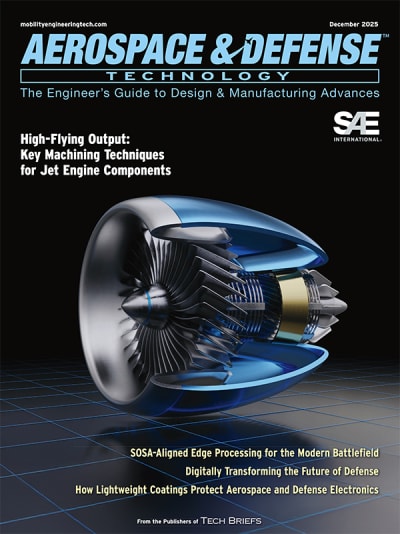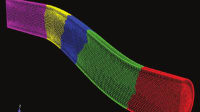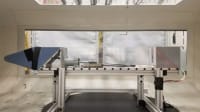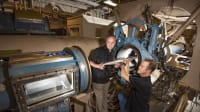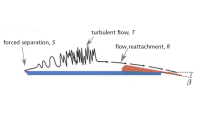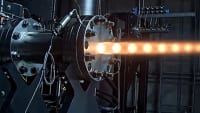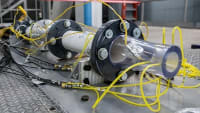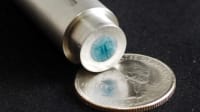Engineers Assess Flow Quality in Wind Tunnel Test Facility

Engineers at the National Full-Scale Aerodynamics Complex don’t always go with the flow. They realize that flow must be examined from time to time, as good flow quality is essential to collecting accurate data from wind tunnel testing. Work recently concluded in the 40-foot by 80-foot wind tunnel housed at NFAC to characterize the flow behavior and quality in this test section.
Staff at NFAC, located at the NASA Ames Research Center on Moffett Field, California, conduct aerodynamic research at large scale on rotor and tiltrotor aircraft, powered lift aircraft, turbine engines, ground vehicles and decelerator systems. The facility also provides a full-scale test capability supporting a variety of research areas, including refueling systems, aero-acoustics and airframe-engine integration.
NFAC is comprised of the 40x80 tunnel and the 80-foot by 120-foot tunnel, the latter being the world’s largest wind tunnel. The 40x80 tunnel, built in the 1940s, serves as a ground test asset for evaluation of future rotor and helicopter technologies, as well as other testing applications ranging from flight safety research to space-based applications.
Accurate calibration and characterization of wind tunnel flow is essential to understanding nearly all test parameters and ensuring proper context and data quality to help customers meet their test objectives. NFAC recently completed a major, multi-phased effort to update the existing flow calibration and characterization in the 40x80 tunnel.
Kyle Lukacovic, NFAC test engineer who served as test director for the latest effort, said the recent assessment focused on characterizing many key aspects of the test section airflow, including steadiness, turbulence, flow angularity, temperature gradients and boundary layer development across the entire operational envelope of the facility from idle flow conditions up to the tunnel’s maximum speed.
“The characterization effort marks the most complete assessment of flow quality through the wind tunnel since the late 1980s,” he said. “It builds on the results of a single-point dynamic pressure calibration completed in early 2017.”
The assessment in the 40x80 tunnel began in December 2021 and wrapped in early May 2022. The flow evaluation used a custom-built test rig, designed and built by personnel at Arnold Air Force Base, Tennessee, headquarters of Arnold Engineering Development Complex. NFAC is an operating location of the 716th Test Squadron, 804th Test Group, AEDC. The test rig comprised a multi-probe array that evenly distributed more than two dozen sensors through the primary area of interest in the tunnel cross section. Each sensor sat at the end of a custom-designed probe holder and sting extension. The rig was then stationed at two different heights, one covering the upper half of the tunnel area, and the other covering the lower half. The top row of probes in the low configuration were coincident with the bottom row in the high configuration, allowing direct correlation between the data sets.
The study also featured nearly 20 thermocouples spread out across the test rig to evaluate tunnel temperature and three boundary layer rakes installed on the tunnel floor to characterize boundary layer growth over the length of the test section. Lukacovic said the rig design process incorporated extensive computational fluid dynamics to minimize the level of flow interference at the location of the probe tips. Arnold personnel also provided stereo photogrammetry support to accurately measure deflections of the rig in test to allow data corrections.
The test team is currently assessing and analyzing data from the flow characterization study. The group expects to publish detailed results in the near future and will repeat the characterization effort on a to-be-determined periodic cadence, especially after any significant changes to the test section or drive system.
Top Stories
INSIDERLighting Technology
![]() Using Ultrabright X-Rays to Test Materials for Ultrafast Aircraft
Using Ultrabright X-Rays to Test Materials for Ultrafast Aircraft
INSIDERManufacturing & Prototyping
![]() New 3D-Printable Nanocomposite Prevents Overheating in Military Electronics
New 3D-Printable Nanocomposite Prevents Overheating in Military Electronics
INSIDERDefense
![]() F-22 Pilot Controls Drone With Tablet
F-22 Pilot Controls Drone With Tablet
Technology ReportAR/AI
![]() Talking SDVs and Zonal Architecture with TE Connectivity
Talking SDVs and Zonal Architecture with TE Connectivity
INSIDERManufacturing & Prototyping
![]() New Defense Department Program Seeks 300,000 Drones From Industry by 2027
New Defense Department Program Seeks 300,000 Drones From Industry by 2027
INSIDERAerospace
![]() Anduril Completes First Semi-Autonomous Flight of CCA Prototype
Anduril Completes First Semi-Autonomous Flight of CCA Prototype
Webcasts
Test & Measurement
![]() SAE Automotive Engineering Podcast: Additive Manufacturing
SAE Automotive Engineering Podcast: Additive Manufacturing
Information Technology
![]() A New Approach to Manufacturing Machine Connectivity for the Air Force
A New Approach to Manufacturing Machine Connectivity for the Air Force
Automotive
![]() Optimizing Production Processes with the Virtual Twin
Optimizing Production Processes with the Virtual Twin
Power
![]() EV and Battery Thermal Management Strategies
EV and Battery Thermal Management Strategies
Manufacturing & Prototyping
![]() How Packet Digital Is Scaling Domestic Drone Battery Manufacturing
How Packet Digital Is Scaling Domestic Drone Battery Manufacturing
Automotive
![]() Advancements in Zinc Die Casting Technology & Alloys for Next-Generation...
Advancements in Zinc Die Casting Technology & Alloys for Next-Generation...

